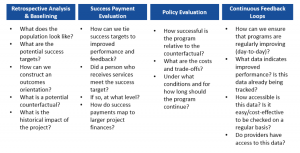Good morning! I’m Brian Beachkofski, lead for data and evaluation at Third Sector Capital Partners, Inc. We are a 501(c)3 consulting firm that advises governments, community organizations, and funders on how to better spend public funds to move the needle on pressing challenges such as economic mobility and the well-being of our children. Our proven approach is to collaborate with our clients and stakeholders to define impact, draw actionable insights from data, and drive outcomes-oriented government. Since 2011, we have helped over 40 communities implement increasingly effective government. We use Pay for Success (PFS) agreements — sometimes called Social Impact Bonds (SIB) — and other outcomes-oriented contracts to help governments and service providers improve outcomes for vulnerable members of their communities. Payment for social services in these projects is directly tied to the impact as measured by a third-party evaluator.
Lessons Learned: In PFS, evaluation has the potential to contribute beyond measuring impact to determine payment. Data, analysis and evaluation all have an important role starting before a project launches and continuing after it concludes.

Evaluation work occurring before the project feeds into the Retrospective Analysis and Baselining effort by providing the evidence base for an intervention. That prior information can indicate who is most at need, who is not benefiting from current practices, which interventions hold more promise, and how much of an improvement can be expected from the intervention.
In the original PFS concept, a Randomized Control Trial determined payment as well as built the evidence to inform scaling of the particular intervention. In our work, we have learned that evaluation best serves two purposes: measuring impact for “success payments” and quantifying impact to inform policy changes. In Santa Clara County’s Project Welcome Home, we evaluate for payment and policy separately.
Even successful PFS projects eventually end. Evaluation, however, provides a path to ensure that the community continues to make progress by embedding feedback into the way government reviews their services. Projects, such as Project Welcome Home, show how government can create a continual feedback loop to see the impact providers have on the people they serve. Once low-cost impact management is embedded as part of normal performance measurement, government can hold service providers accountable for quantifiable effectiveness while encouraging greater innovation.
Rad Resource: Stay in touch with the Pay for Success community and the role of evaluation in projects on our blog. You can also find more resources on Pay for Success here.
The American Evaluation Association is celebrating Social Impact Measurement Week with our colleagues in the Social Impact Measurement Topical Interest Group. The contributions all this week to aea365 come from our SIM TIG members. Do you have questions, concerns, kudos, or content to extend this aea365 contribution? Please add them in the comments section for this post on the aea365 webpage so that we may enrich our community of practice. Would you like to submit an aea365 Tip? Please send a note of interest to aea365@eval.org. aea365 is sponsored by the American Evaluation Association and provides a Tip-a-Day by and for evaluators.
